Visit To Worms, Germany
20 September 2012
by
Lynn E. Garn, Ph.D.
The city of Worms, Germany, has a number of things that make it worth visiting. Worms is where Martin Luther was tried by the Catholic Church for heresy in 1521 and declared an outlaw and heretic. Today the city has some beautiful monuments that honor him. Worms also boasts the oldest Jewish Cemetery in Europe, with one grave dating to 1076 AD. Two churches, a Catholic cathedral and Trinity Church, which was built in Martin Luther's honor, are also worth visiting.
Stan and I started our visit to Worms by visiting Trinity Church, a church
built to honor Martin Luther. The picture below shows the front of the church from
the inside and a look through the stained glass windows.
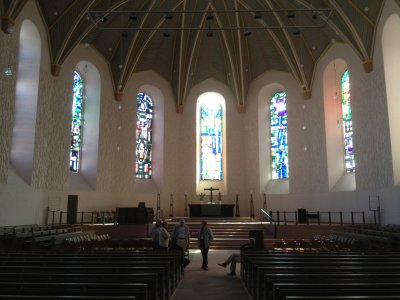
Front Of Trinity Church
The picture below is also from inside Trinity Church in Worms. It shows the
stained glass windows on one side of the church and a small part of the balcony at
the back of the church.

Inside Trinity Church
The picture below shows the balcony of Trinity Church.
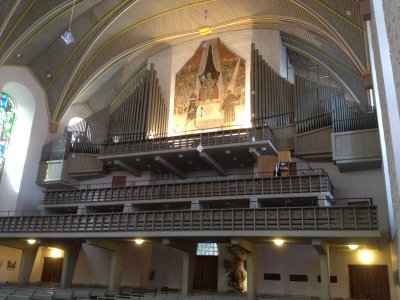
Balcony Of Trinity Church
The art work or picture in the middle of the balcony in the picture above is
worth describing. It is of the trial of Luther for heresy. The Emperor, King
Charles, is seated hearing the case against Luther. On the left below the King
is the representative of the Church or Pope presenting the case against Luther.
And Luther is on the right below the King. Note the ray of sunlight beaming down
on Luther as a sign that God was on Luther's side in the hearing. This painting
or fresco was added when the church was rebuilt after World War II and is
believed to have been patterned after a similar painting that was in the church
before the war.
Trinity Church was destroyed in an air raid during World War II. When the
church was rebuilt, some of the artifacts from the previous church were included
in the present day church. The picture below shows some of the artifacts from
the earlier church.

Artifacts From Early Trinity Church
The picture below shows a metal plate mounted on the outside of Trinity Church,
which tells about the former city hall and mint that once stood where the church is
located and was destroyed by an army of French King Louis XIV. Stones from the former
city hall were used to build the church.
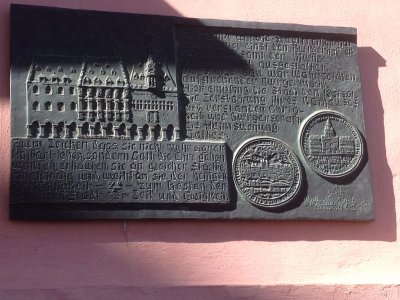
Plate On Trinity Church
The Diet of Worms that was held in 1521 in the former city hall and mint that
once stood where Trinity Church is located. Luther's trial was only a small part of
the Diet, which conducted a lot of other business. It was once believed that Luther's
trial was also held in the city hall. However, papers have been discovered that
reveal that his trial was held at the Bishop's Quarters of the nearby Worms Cathedral.
The pictures below are of decorated metal doors on Trinity Church. The pair of doors
on the left show Biblical themes. The single door on the right draws a parallel between
Sodom and Gomorrah of Biblical times and Worms during World War II. At the upper right of
the door one may see Abraham praying symbolically for Worms. On the left side of the door
one may see Lot's wife fleeing Sodom and Gomorrah. And on the bottom is a scene of Worms
burning.
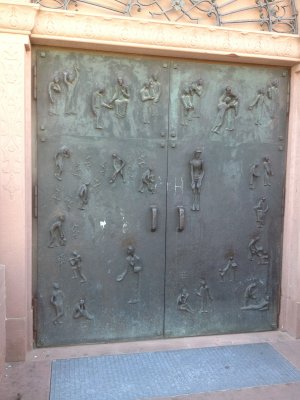
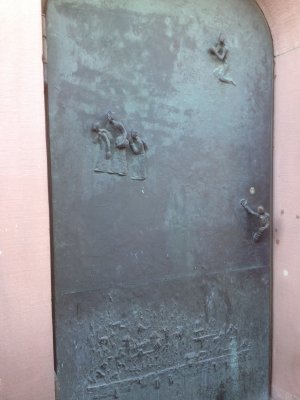
Metal Doors On Trinity Church With Biblical
Themes
Metal Door On Trinity Church Comparing Worms
With Sodom And Gomorrah
The picture below shows the original Rathaus or City Hall, which stood
on the site where Trinity Church now stands. The building was called the
Münze, for Mint. It was said to be a magnificent building and the pride of all
of the citizens of Worms. The label at the bottom of the picture implies that the
building was destroyed in 1689. This picture was mounted in present-day Trinity
Church.
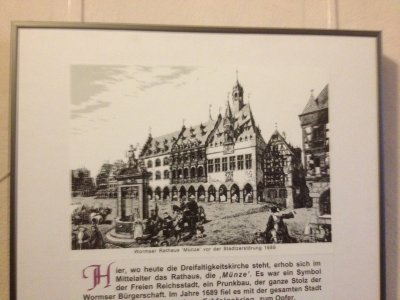
Photo Description
The picture below is of the inside of Trinity Church as it looked before
the church was destroyed in an air raid during World War II. The words in German
at the bottom of the picture report that it is the pulpit and minister's seat.
This picture was mounted in present-day Trinity Church.
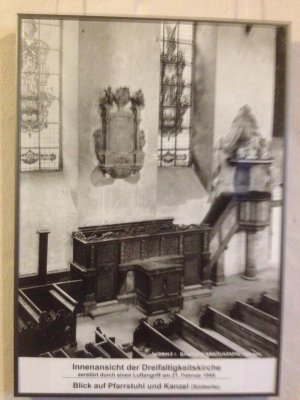
Pulpit And Minister's Seat At Old Trinity Church
The picture below is another view of the inside of the old Trinity Church.
The words in German at the bottom of the picture report that it was destroyed in an
air raid on 21 February 1945. Worms was bombed more heavily than most German cities during
World War II because there was a major bridge crossing the Rhine at Worms.
This picture was mounted in present-day Trinity Church.
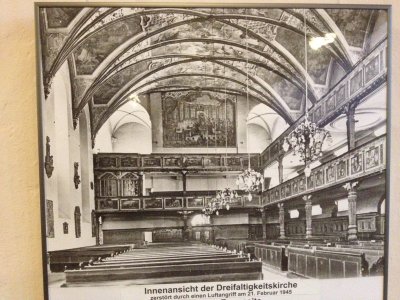
Inside View Of Old Trinity Church
In the picture of the inside of the old church shown above, one may see the
painting on the wall of the balcony. It is believed that this is a painting of Luther's
trial that inspired the painting seen today in the balcony of Trinity Church.
The picture below is another view of the inside of the old Trinity Church.
The words in German at the bottom of the picture report that it was destroyed in an
air raid on 21 February 1945. They also say that the view is, "Facing the altar and
the organ." This picture was mounted in present-day Trinity Church.
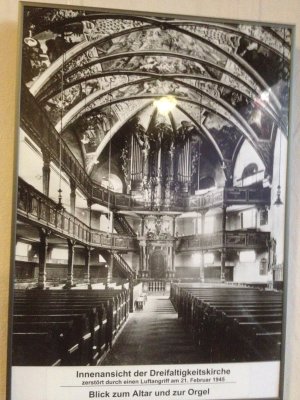
Inside View Of Old Trinity Church
The picture below is of the old Trinity Church after it was destroyed during
World War II. The words in German at the bottom of the picture say, "Burned out ruins
of the Trinity Church." This picture was mounted in present-day Trinity Church.
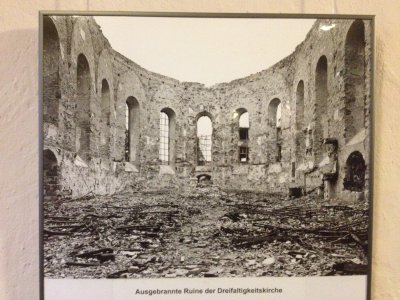
Burned Out Ruins Of Trinity Church
When the church was destroyed during World War II, it took some time to rebuild.
However, the congregation still held church services in the church immediately after
the war and for several years before a roof was added to the church.
The picture below is another view of the inside of the old Trinity Church.
The words in German at the bottom of the picture report that it was destroyed in an
air raid on 21 February 1945. This picture was mounted in present-day Trinity Church.

Trinity Church After Its Destruction
The picture below shows Kämmererstraße (Kammerer Street) in Worms
after it's destruction in the air raid of 21 February 1945 with Trinity Church
on the left. This picture was mounted in present-day Trinity Church.

Kämmererstraße And Trinity Church In Ruins
The name of Trinity Church in German is Dreifaltigkeitskirche. The GPS coordinates of Trinity
Church or Dreifaltigkeitskirche discussed above are
49.630109N, 8.361711E. Click on the coordinates to see the location on
Google Maps.
The pictures below show the time disk in the market square in Worms, which has
scenes in relief of events that are important in the history of Worms. In the picture
on the left one may see the cathedral between 2 and 3 o'clock on the disk. The key in
the center represents Peter, Patron Saint of Worms. Other relief items are for other
things important in Worms' history. The wheel turns as if telling the story from the
beginning of Worms' history until the present and then begins all over again to tell
the story again with each revolution. Interestingly, the Germans call it the Wheel of
Fortune, probably after the American game show in which a large wheel is turned.
However, the wheel at Worms turns a lot slower than the wheel in the American game
show.
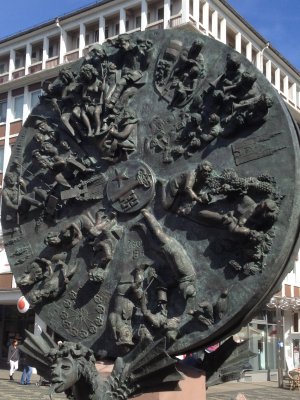

One Side Of Time Disk In Market Square In Worms
Opposite Side Of Time Disk In Market Square In Worms
The picture below shows two versions of a sign on a bank in Worms. The sun shone
brightly on the top making it hard to photograph both the top and bottom in a way that
made the words legible. The picture on the left has had the brightness and contrast
adjusted to make it easier to see the words.
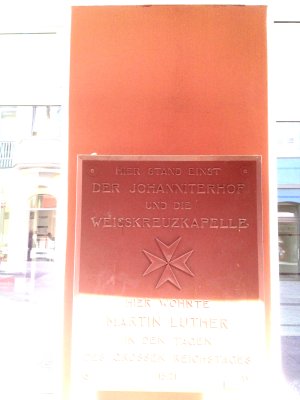
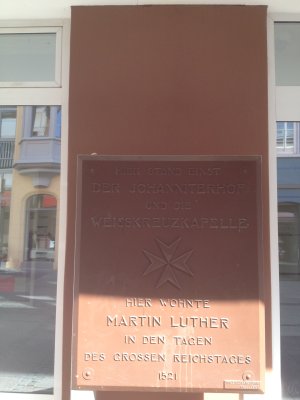
Sign Marking Place Where Martin Luther
Stayed During The Diet Of Worms
Sign Marking Place Where Martin Luther
Stayed During The Diet Of Worms
The words on the sign say that it was the former location of White Cross
Chapel and that Martin Luther stayed there during the "Great Diet." Luther had been
an Augustinian priest. And normally he would have been given a room with the other
priests who were attending the Diet and were staying at the cathedral. However, he
had already been excommunicated and was not allowed to stay with the others, which
explains why he stayed in the White Cross Chapel formerly at the site of the sign.
The picture below shows statues in Worms of Martin Luther and others who were played important roles in the Protestant Reformation. Martin Luther is standing in the center. Beside Luther are Frederick the Wise of Saxony and Philip of Hesse, two princes whose support was critical to the political success of the Reformation. Behind Luther are Johannes Reuchlin and Philipp Melanchthon, two scholars who were important to the Reformation. Seated around Luther are Peter Waldo, John Wycliffe, Jan Hus and Girolamo Savonarola, considered the main forerunners of the Reformation and also the victims of the Catholic Church's reaction to their outspoken preaching against the Church's excesses.
Peter Waldo was declared a heretic and excommunicated from the Church. The
Church's delayed reaction to John Wycliffe is quite interesting and unusual. Thirty
years after his death, the Catholic Church declared him to be a heretic, had his
body exhumed, burned, and his ashes thrown into a river. Jan Hus was burned at the
stake for heresy. Girolamo Savonarola was first hanged and his body then burned for
heresy. Luther would likely have been put to death also had it not been for the
support of the princes cited above. The statues of women who are seated around Luther
represent the German cities that first adopted Protestantism. Names of other towns
that were important in the Reformation also appear with the statues.
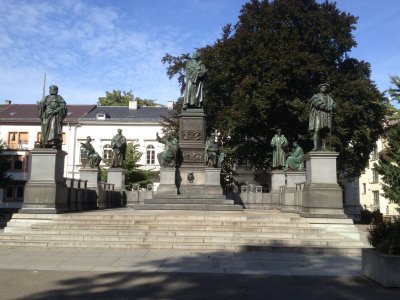
Statues Of Martin Luther And Other Contributors
To The Protestant Reformation
The statue complex for Luther and the others shown above is the primary statue
for representing the Protestant Reformation. It was designed of large stones with
three strong walls surrounding it. It is intended to represent a fortress as in
the song, "A Mighty Fortress," which Martin Luther himself wrote.
The GPS coordinates of the Martin Luther Monument are 49.63227N, 8.360068E. Click on the coordinates to see the location on Google Maps.
The picture below shows a close-up of the statue of Martin Luther in Worms.
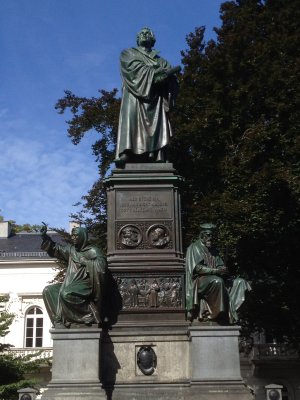
Statue Of Martin Luther
One interesting thing of note about this statue is that it is one of two
that are identical. The other that is like it is located at Luther Place Memorial
Church on Vermont Avenue in Washington, DC.
The picture below is a closer view of the pedestal on which Martin Luther
is standing and gives a better view of the text on the sign on the pedestal. In
German it says Hier stehe ich, Ich kann nicht anders, Gott helfe mir! Amen!
This translates to something like Here I stand, I can do no more, God help me!
Amen!

Close-up Of Inscription On Martin Luther Statue
The picture below shows another view of the statues in Worms of Martin
Luther and others who took a stand against the practices of the Catholic Church
over the years.
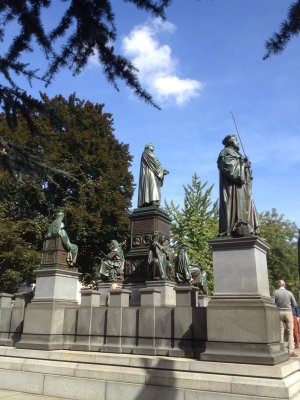
Statues Of Martin Luther And Others Who
Opposed The Catholic Church
The picture below is the sign at the entrance to the old Jewish cemetery
in Worms. The GPS coordinates of the entrance to the Jewish cemetery are
49.629704N, 8.356736E. Click on the coordinates to see the location on
Google Maps.
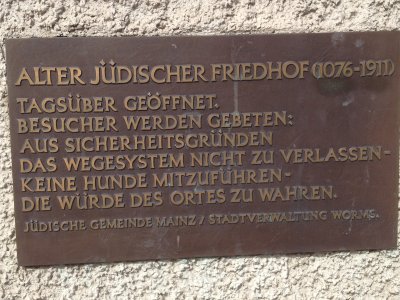
Sign At Entrance To Jewish Cemetery In Worms
This cemetery is the oldest Jewish cemetery in Europe. One of the graves dates to
the year 1076 AD. Prior to Kristallnacht in November 1938, when the Nazis instigated attacks
on Jewish homes and properties all over Germany, there was a large population of Jews in
Worms, especially Jewish scholars. After World War II, the Jewish population in Worms ceased to
exist. Today there are very few if an Jews in Worms. Incidentally, Kristallnacht means Night
of Broken Glass, when glass in homes, shops and synagogues of Jews was broken.
It was the presence of Jewish scholars in Worms that drew William Tyndale of England to Worms in the early 1500s. Although the Bible was available in several European languages, no English Bible existed. And rather than translate the Bible into English from the Latin version authorized by the Catholic Church or from one of the European languages, Tyndale intended to translate it from the original Greek and Hebrew to improve the accuracy of the translation. When the Catholic Church learned of Tyndale's plans, they issued an edict against such a translation into English. But Tyndale ignored the edict. Although Tyndale was familiar with Greek, his grasp of Hebrew was not sufficient for him to translate the Bible from Hebrew. Also, at that time England had expelled Jews from the country. So Tyndale, wishing to use Jewish scholars as a sounding board for his translation, went to Worms to do his translation. There he used Jewish scholars to insure the correct translation from Hebrew.
It is an interesting historical footnote that the first English translation of the Bible was printed in Worms, Germany. Once Tyndale had completed his translation of the Bible into English, he had it printed in Worms. Since Worms was situated on the Rhine River, it had a ready supply of paper for printing. English‑language Bibles printed there were smuggled into England by placing them in cargo bound for England.
In 1535 Tyndale was arrested and placed in prison in Belgium. A year later he was tried for heresy and executed by strangulation. His body was then burned at the stake. His dying wish was that the eyes of the King of England would be opened. Two years later King Henry VIII, then King of England, authorized "The Great Bible," which became the first authorized Bible in the English language. Much of it was based on Tyndale's translation of the Bible. Thus, after his death, Tyndale's views continued to influence the Protestant Reformation. It has been estimated that more than 75% of both the Old Testament and New Testment portions of the King James Version of the Bible, which was completed in 1611, are verbatim from Tyndale's version of the Bible.
The pair of graves in the picture below are of two Jewish men who were revered in the
Jewish community, Meir of Rothenburg on the left and Alexander ben Salomo Wimpfen on the right.
Meir of Rothenburg was a respected rabbi and poet. During an earlier persecution of the Jews in
1286, Meir of Rothenburg attempted to escape with his family but was captured and imprisoned.
Tradition holds that his supporters raised a huge sum of money as a ransom to gain his
freedom. But the rabbi refused it out of fear that it would only encourage the capture and
imprisonment of other rabbis. He died in prison in 1293, seven years later. However, the
King, who had imprisoned him, would not release his body to his followers. Fourteen years
later Alexander ben Salomo Wimpfen, on the right in the picture, paid a huge ransom for his
body in return for the privilege of being buried next to the rabbi.
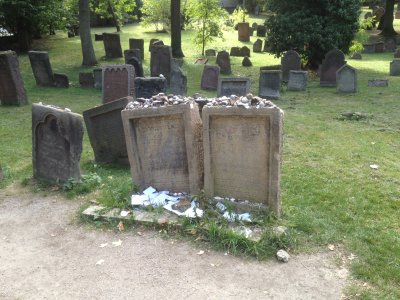
Graves Of Meir of Rothenburg (Left) And Alexander
ben Salomo Wimpfen
The rocks placed on top of the grave markers in the picture above are part of a
tradition among Jews. This is believed to have grown from the practice of Jews in Palestine
placing rocks on graves of people they buried in the soft ground to prevent animals from
digging up the body. Over time it is believed the practice transitioned to become a sign of
respect.
The picture below shows a closer view of the graves of Meir of Rothenburg on the left
and Alexander ben Salomo Wimpfen on the right.
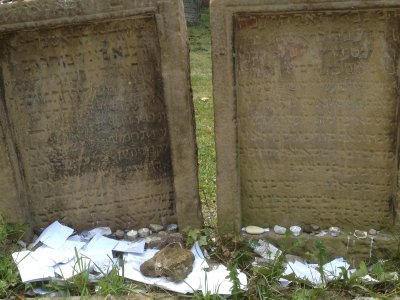
Graves Of Meir of Rothenburg (Left) And
Alexander ben Salomo Wimpfen
The picture above shows many notes on grave of rabbi. The people leaving the notes,
believing he is in heaven, hope for him to read them so that he can be an intercessor for
them. It is sort of like when Jews leave notes in wailing wall in Jerusalem.
The picture below shows some of the graves in the Jewish cemetery in Worms.
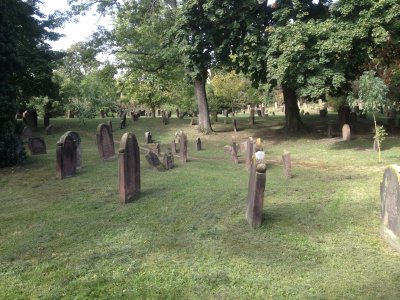
Graves In Jewish Cemetery In Worms
The picture below shows another view of some of the graves in the Jewish
cemetery in Worms.
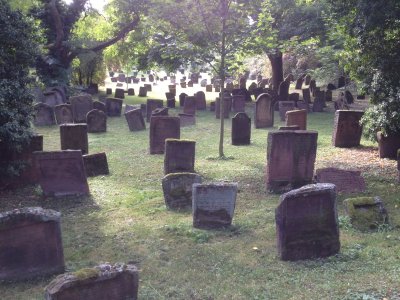
Graves In Jewish Cemetery In Worms
The picture below shows one of the graves in the Jewish Cemetery in Worms with the inscription in the old Hebrew writing. Also seen are the hands pointing upward with the fingers separated. These are known as "Blessing Hands." The grave markers with Blessing Hands are for men who belonged to the priestly order of Jews and were descendants of the Levites. These men held positions of authority in the church and often had names like Cohen and Cahn, Kuhn, and variations of these names. The name Cohen in Hebrew means priest.
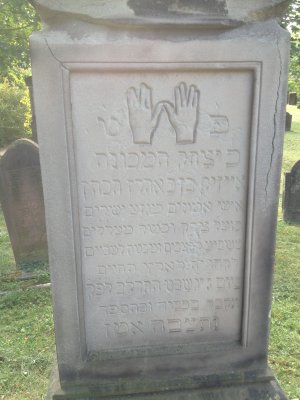 |
| Grave In Jewish Cemetery In Worms With Inscription In Hebrew |
The picture below shows the grave marker for Alexander Mannheimer with the
inscription in German. When Napoleon conquered this region of Germany in the early
1800s, he mandated that people have family names, which is why names like
Mannheimer appear in the cemetery around this time. Note also that the inscription
on the grave marker is in German. Names in the older part of the cemetery were in
Hebrew. In the newer part of the cemetery names are in German. It is not known if
the sudden use of German inscriptions is because the Jews gradually moved away from
using Hebrew or if some government mandate required them to use the German inscriptions.
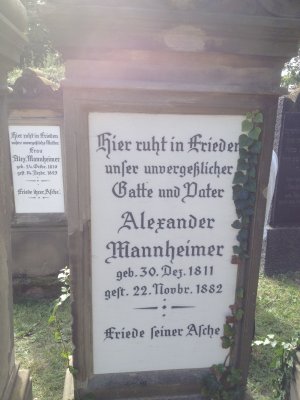
Grave Marker For Alexander Mannheimer In
The Jewish Cemetery In Worms
The grave marker in the picture below shows evidence of shooting in the
vicinity during World War II. One may easily see bullet holes in one of the inside
walls of the cemetery near this marker also.
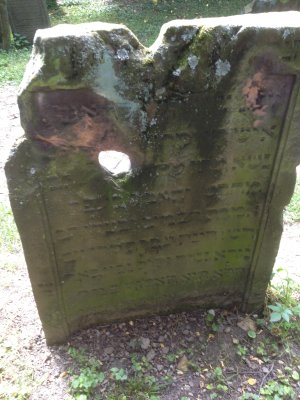
Grave Marker With Bullet Hole
This Jewish cemetery is unique among Jewish cemeteries in that the graves
do not face Jerusalem. The only exception is the one grave shown in the picture
below. The person buried under this marker insisted on having his marker
facing toward Jerusalem.
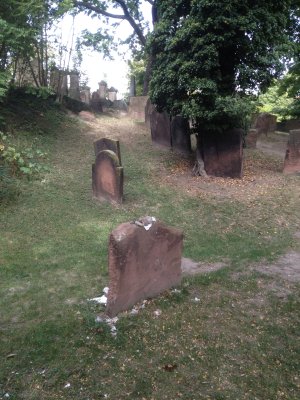
Grave Marker Facing Jerusalem
The picture below shows the old grave markers. The one on the right is
the oldest marker in the cemetry, said to date to 1076 AD.
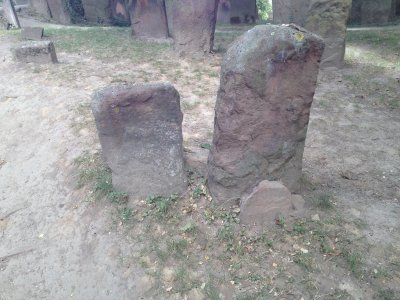
Oldest Grave Marker (On Right) In Jewish
Cemetery In Worms, Dating From 1076 AD
One might wonder how a Jewish cemetery survived the years the Nazis ruled
Germany with all of the killing of the Jews and the destruction of their property.
It was reported that Heinrich Himmler visited Worms early in World War II and
actually was shown the cemetery. Some time later one someone in Worms wanted to plow under
the cemetery to build something. A quick thinking resident, probably knowing the
historical value of the cemetery, stepped forward and confidently reported that
Himler liked the cemetery when he visited it and that he would be displeased
to learn that it had been destroyed. There was never any evidence
that Himler ever voiced an opinion on the cemetery and likely might have even
called for its destruction if asked. However, a quick thinking resident took a
chance and preserved the cemetery from destruction during World War II.
The picture below shows a scale model of the Catholic Cathedral in Worms. This cathedral goes by many different names: Worms Cathedral, St. Peter's Cathedral, Kaiserdom, Wormser Dom, Dom St. Peter and Dom Sankt Peter.
This scale model is on the cathedral grounds just outside the cathedral. It has
has lots of braile writing on it so the blind can read all about the cathedral in addition
to feeling the shape of the cathedral.

Scale Model Of Worms Cathedral
The GPS coordinates of the Worms Cathedral are
49.630151N, 8.359764E. Click on the coordinates to see the location on
Google Maps.
The picture below shows the actual Catholic Cathedral or Worms Cathedral. The cathedral
has an interesting history. During one of the wars between France and Germany, France conquered
the area around Worms. Citizens of Worms, thinking the cathedral would be spared, placed a lot
of their furniture in the cathedral. The French burned it anyway. For a while afterward, the area
inside the cathedral was used as a barn.
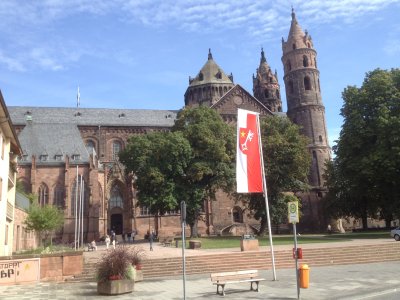
Worms Cathedral
The picture below is another view of Worms Cathedral
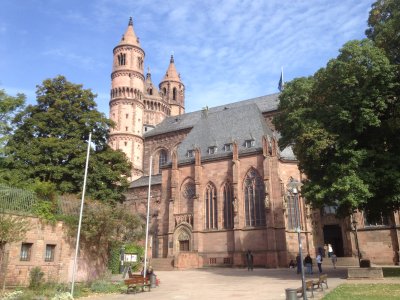
Another View Of Worms Cathedral
And the picture below shows a view of two of the towers on Worms Cathedral.
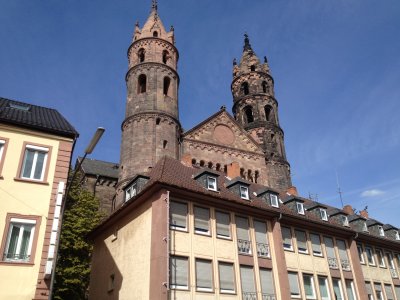
Worms Cathedral Towers
The picture below is of the statue of Bishop Burchard outside Worms Cathedral.
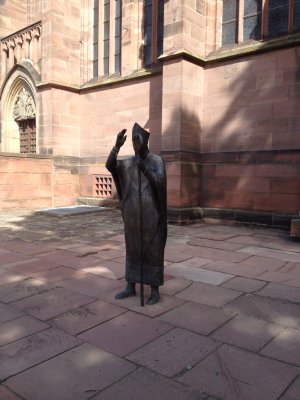
Bishop Burchard
Worms Cathedral is also known as St. Peter's Cathedral. The statue in
the picture below is of St. Peter. Note how his right foot and to a lesser
extent his knees have been polished. Many visitors rub his right foot or one
of his knees for good luck.
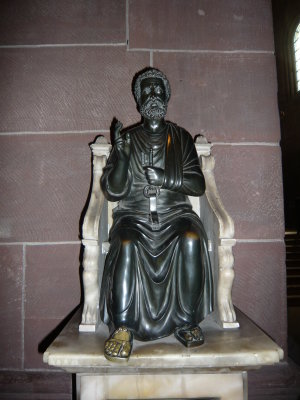
Statue Of St. Peter
The pictures below show views of the inside of Worms Cathedral.
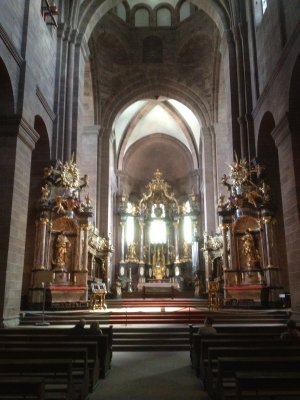

Worms Cathedral Nave, Looking Toward The High Altar
Worms Cathedral's Romanesque West Choir
The picture below is of one of the stained glass windows at Worms Cathedral. The thing
that makes it interesting is the panel with Martin Luther, which may be seen in the rectangular
array of panels two rows from the top and two rows from the right in the picture. Luther is dressed all
in black, possibly to signify that he was considered a sinner by the Catholic church, and is
holding a red book.
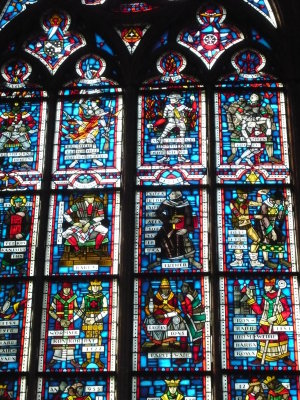
Stained Glass Window At Worms Cathedral With Panel
Showing Martin Luther
An interesting note of history is that the Lutheran Church has called on the Catholic
Church to lift Luther's excommunication. Although comments by recent Popes have softened
considerably the Catholic Church's position regarding Luther, the excommunication has
not been lifted. Given the Church's current position on Luther, is it possible that the
panel about Luther in the stained glass window above was added in anticipation of huge
crowds expected to visit Worms in 2021 on the 500th anniversary of the Diet At Worms when
Luther was declared a heretic?
When Stan and I left Worms, we headed toward Frankfurt to a motel near the airport to stay the night and be close to the airport for an early flight the next day. When Stan and Jan lived in Germany and had to catch a flight, they always stayed the night before at the same motel in Raunheim near the airport. And they always ate dinner at the same restaurant near the motel. The name of the restaurant in German was Zur Ziegelhütte. The sign on the restaurant also had the English words, "Corner Steakhouse." Since Stan was accustomed to eating at this restaurant and liked the food, we decided to eat there, a walk of about half a mile from the motel where we had checked in.
As we were approaching the restaurant and standing on the corner waiting to cross
the street, Stan snapped the picture below and attached it to a text
message he intended to send to Jan that said, "Guess where I'm eating tonight." However,
before he could send his message, a message arrived from Jan declaring, "I know where
you're eating tonight." Stan immediately hit the send button to transmit the picture and
his message to Jan. He followed it immediately with another text message asking Jan, "Do you
have someone spying on
us?"
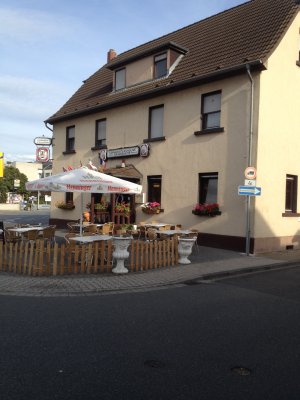
Steakhouse Near
The GPS coordinates of the Corner Steakhouse are
50.015227N, 8.456486E. Click on the coordinates to see the location on
Google Maps.
Stan and I were both hungry and ordered big meals. The steaks they sell are brought out
raw on a large slab of hot granite that cooks the meat in front of you. We just cut off chunks
of the meat and placed the side of the meat we wanted to cook against the hot granite. It was
excellent. The pictures below show Stan and me with our steaks.
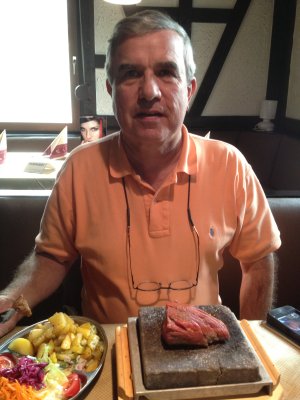
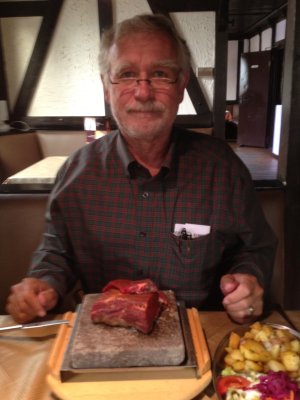
Stan With His Steak On A Rock
Me With My Steak On A Rock
When we left the restaurant and headed back to our motel, we passed a place that sold
grave markers. In the fenced yard beside the place were lots of markers and one curious thing
that caught my attention, a scale model of R2D2 from the Star Wars movie. I just had to
photograph it. I have no idea why it was there. Possibly someone planned to use that as part
of their grave marker. Who knows? In the background behind R2D2 one can see a few of the
grave markers in the yard beside the sales office.
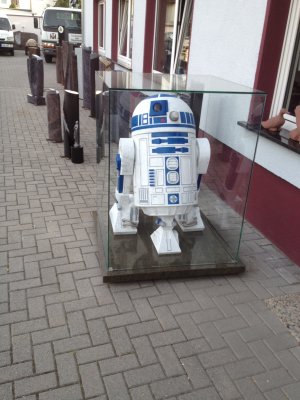
R2D2 Model At Grave Marker Sales Office
The next morning Stan and I rose early and headed to the airport on the bus that runs
from the motel to the airport. As we were riding, I noticed several contrails of jets in the
sky over Frankfurt, which may be seen in the photo below. They weren't rainbows. But we took
it as a sign that we were going to have a good day and a good flight back, which we did.
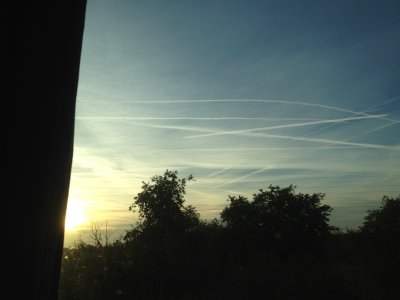
Jet Trails Over Frankfurt
Stan and I both had a great time. For me it was the trip of a lifetime to visit the
ancestral home of the Garn family, to see the vineyards where they worked, the church
where they worshipped, the old church books with records of their births and christenings,
to stay in a guest house where they might have stayed and to walk the streets that they
walked. The other places we visited while in Europe just made the trip more memorable. I'd
go back in a minute.
To contact me by mail, write:
Mr. Lynn E. Garn
12210 Redwood Ct.
Woodbridge, VA 22192-1611
USA
Or email me at:

Updated on 15 February 2013